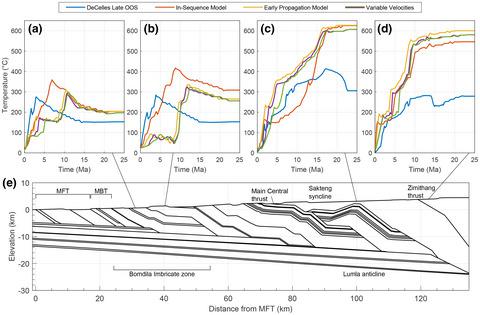当前位置:
X-MOL 学术
›
Basin Res.
›
论文详情
Our official English website, www.x-mol.net, welcomes your feedback! (Note: you will need to create a separate account there.)
Determining the tempo of exhumation in the eastern Himalaya: Part 1. Geometry, kinematics and predicted cooling ages
Basin Research ( IF 3.2 ) Pub Date : 2021-09-07 , DOI: 10.1111/bre.12615 Mary Braza 1 , Nadine McQuarrie 1
Basin Research ( IF 3.2 ) Pub Date : 2021-09-07 , DOI: 10.1111/bre.12615 Mary Braza 1 , Nadine McQuarrie 1
Affiliation

|
Quantitative integration of cross-section geometry, kinematics and cooling ages requires notably more complicated kinematic and exhumation pathways than are typically assumed with a simple in-sequence model of cross-section deformation. Incorporating measured basin thickness and depositional ages, determined from magnetostratigraphy or young detrital zircon fission track cooling ages, provide further constraints on the timing of fault motion, as changes in shortening rate that may not alter bedrock cooling ages can affect the depositional age of foreland basin strata. Thermokinematic models of balanced cross-sections in Arunachal Pradesh, NE India demonstrate that the kinematic sequence and shortening rate exert the largest control over the pattern of predicted cooling ages for the region, by dictating the location and timing of rock uplift and exhumation (cooling) over ramps. The best fit to the measured bedrock cooling ages and basin constraints is achieved with a kinematic sequence involving early foreland propagation of four Lesser Himalayan faults combined with variable shortening rates. Fast rates (25–30 mm/yr) are required to accompany early foreland propagation at ca. 14–13 Ma followed by slower rates (18–20 mm/yr) until 10 Ma. Shortening rates increase to ca. 25–35 mm/yr at ca. 10 Ma until ca. 5–7 Ma. A decrease in shortening rate occurs between 7 and 5 Ma, with rates of 9–15 mm/yr until the present. Although non-unique, the updated cross-section geometry and kinematics highlight the components of geometry, deformation and exhumation that must be included in any valid cross-section model for this portion of the eastern Himalaya such as the location of active ramps, and location and age of two key fault systems, the Bomdila imbricate zone and the thrust faults that form the Lumla duplex. Less unique are the specific geometries of faults, thickness of strata they carry, shortening rates, particularly between 14–8 Ma, and model parameters such as topography, heat production and flexure.
中文翻译:

确定喜马拉雅东部的挖掘速度:第 1 部分。几何学、运动学和预测的冷却年龄
横截面几何形状、运动学和冷却年龄的定量整合需要比简单的横截面变形顺序模型通常假设的更复杂的运动学和折返路径。结合测量的盆地厚度和沉积年龄,由磁地层学或年轻碎屑锆石裂变轨迹冷却年龄确定,进一步限制了断层运动的时间,因为可能不会改变基岩冷却年龄的缩短率的变化会影响前陆盆地的沉积年龄地层。印度东北部阿鲁纳恰尔邦平衡截面的热运动模型表明,运动序列和缩短率对该地区预测的冷却年龄模式施加了最大的控制,通过规定斜坡上岩石隆起和挖掘(冷却)的位置和时间。与测量的基岩冷却年龄和盆地限制的最佳拟合是通过运动学序列实现的,该序列涉及四个小喜马拉雅断层的早期前陆扩展以及可变缩短率。大约需要快速的速度(25-30 毫米/年)来伴随早期的前陆繁殖。14-13 Ma,然后是较慢的速率(18-20 mm/yr),直到 10 Ma。缩短率增加到约。大约 25–35 毫米/年。10 ma 直到 ca。5-7 毫安。缩短率下降发生在 7 到 5 Ma 之间,直到现在的速率为 9-15 毫米/年。虽然不是唯一的,但更新的横截面几何和运动学突出了几何的组成部分,任何有效的横断面模型中都必须包含变形和折返,例如活动斜坡的位置,以及两个关键断层系统的位置和年龄,即 Bomdila 叠瓦带和形成断层的逆冲断层。 Lumla 双工。不太独特的是断层的具体几何形状、它们携带的地层厚度、缩短率,特别是在 14-8 Ma 之间,以及诸如地形、产热和弯曲等模型参数。
更新日期:2021-09-07
中文翻译:

确定喜马拉雅东部的挖掘速度:第 1 部分。几何学、运动学和预测的冷却年龄
横截面几何形状、运动学和冷却年龄的定量整合需要比简单的横截面变形顺序模型通常假设的更复杂的运动学和折返路径。结合测量的盆地厚度和沉积年龄,由磁地层学或年轻碎屑锆石裂变轨迹冷却年龄确定,进一步限制了断层运动的时间,因为可能不会改变基岩冷却年龄的缩短率的变化会影响前陆盆地的沉积年龄地层。印度东北部阿鲁纳恰尔邦平衡截面的热运动模型表明,运动序列和缩短率对该地区预测的冷却年龄模式施加了最大的控制,通过规定斜坡上岩石隆起和挖掘(冷却)的位置和时间。与测量的基岩冷却年龄和盆地限制的最佳拟合是通过运动学序列实现的,该序列涉及四个小喜马拉雅断层的早期前陆扩展以及可变缩短率。大约需要快速的速度(25-30 毫米/年)来伴随早期的前陆繁殖。14-13 Ma,然后是较慢的速率(18-20 mm/yr),直到 10 Ma。缩短率增加到约。大约 25–35 毫米/年。10 ma 直到 ca。5-7 毫安。缩短率下降发生在 7 到 5 Ma 之间,直到现在的速率为 9-15 毫米/年。虽然不是唯一的,但更新的横截面几何和运动学突出了几何的组成部分,任何有效的横断面模型中都必须包含变形和折返,例如活动斜坡的位置,以及两个关键断层系统的位置和年龄,即 Bomdila 叠瓦带和形成断层的逆冲断层。 Lumla 双工。不太独特的是断层的具体几何形状、它们携带的地层厚度、缩短率,特别是在 14-8 Ma 之间,以及诸如地形、产热和弯曲等模型参数。


























 京公网安备 11010802027423号
京公网安备 11010802027423号